Nail fungus is a dangerous disease, many people do not recognize the first symptoms and seek medical attention when the disease is advanced. At this stage, it is impossible not to notice the signs, the nail begins to collapse, peel off, the inflammation spreads to the skin, the surrounding areas become inflamed. To take timely action, you need to know what toenail fungus looks like.
Almost two-thirds of the world's population faces manifestations of fungal infections. Nail fungus or nail damage is not only a cosmetic problem, at a later stage, the disease begins to cause discomfort to the body.
Toenail fungus is difficult to treat, and it responds better to treatment if you start taking measures in its early stages. And for this you need to know what a fungal nail looks like.
Description of the disease
A fungal disease that affects the nails is called onychomycosis. The fungus penetrates deep into the nail plate and destroys the keratin that is the basis of the nail plate. Fungal spores penetrate the intercellular space and begin to multiply rapidly. If the infection is not treated, it will affect the nail, and if not treated adequately, it will spread to nearby skin.
If the infection is not treated, it will affect the nail, and if not treated adequately, it will spread to nearby skin.
infection
In the medium there are fungal spores. They are very resistant to external influences, the spores do not die even at sub-zero temperatures. However, active reproduction of the fungus can only occur in warm and humid environments, Therefore, people are most at risk when going to public baths, swimming pools, gyms.
If among the visitors there is a person infected with nail fungus, then on the things with which he has been in contact, the fungal spores remain active for a long time. And these spores affect the skin and nails of healthy people. To "catch" an infection, simply walk barefoot on the floor, on which there are fungal spores.
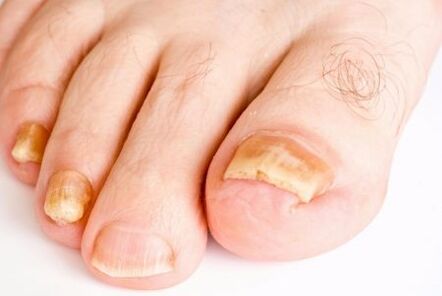
Advice! Wood surfaces are especially dangerous - floors, mesh in the bathroom, benches. The fact is that the plant has a porous structure, even thorough disinfection cannot destroy the spores of pathogenic microorganisms.
But, of course, not every "encounter" with fungus ends in illness. In most cases, the body's immune system successfully fights off the infection. But if the body is debilitated or the person does not follow basic hygiene measures, the likelihood of nail fungus increases.
Factors that contribute to the development of the disease
In order for the mushroom to begin its licensing activity, certain conditions must be met. Usually, the elderly are susceptible to the disease, they have a weakened immune system, so nail fungus in the elderly is observed more than in the young. Risk factors:
- failure to observe hygiene rules, wearing shoes that are too tight, clothes and shoes made of synthetic materials;
- the presence of any damage to the skin, even a small scratch, is the "gateway" for infection;
- pathology of the endocrine system;
- chronic diseases that weaken the immune system;
- long-term use of drugs, especially hormones, cytostatics and antibiotics.
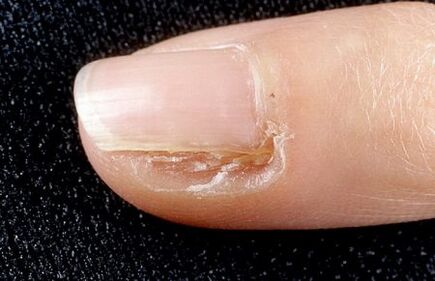
Advice! You can get nail fungus in the salon when you get a manicure or pedicure. If the worker does not pay due attention to the sterilization of the tool, the files from the cutter can become a source of infection.
Pathogens
To date, about 50 types of fungi have been identified that can cause onychomycosis. For this reason, you should not self-medicate. Drugs that are effective against one type of nail fungus may be ineffective if the disease is triggered by pathogens of another fungus.
The complexity of treatment lies in the fact that the infection is localized not on the surface of the nail, but under the nail plate. Therefore, external use of the drug does not always give the expected effect. If left untreated, the disease will continue to progress. Moreover, the earlier the disease begins, the more difficult it is to cure.
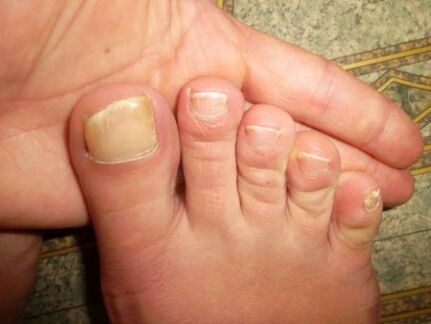
Toenail fungus usually occurs on the feet. The infection may affect the nail of the toe first, but over time it can spread to other nails. Fungus on the hands is much less common, but this disease should not be considered rare.
Medical clinic
Symptoms depend on the form and stage of the lesion, so it is not possible to unequivocally answer the question of what fungus on the nails looks like.
The most common case
The initial stage is called normalization. At this stage, the symptoms are still faint, so many patients do not pay attention. Typically, you may see the following signs:
- loss of transparency;
- the appearance of yellow spots, most often on the outer edge;
- sometimes there is a feeling that a "gap" has formed between the nail and the nail bed.

This lesion is called the distal side and is the most common. If no treatment is given, the process begins to progress. Presence of keratosis under the skin. This phenomenon is characterized by the growth of keratinocytes, as a result of which the nail becomes thicker.
Advice! Hyperkeratosis is a normal response of the nail to an infection. Furthermore, the deeper the infection penetrates the nail plate, the thicker the nail becomes.
At a later stage, complete damage of the nail plate is noted, signs of dystrophy appear. Gradually, the matrix also participates in the process - the place from which the nail grows. At this stage, even the removal of the nail will not yield results, since the patient's nails have already begun to grow.
Surface form
In the early stages, white spots appear on the nails in this form. Over time, they grow, taking up the entire surface of the nail. Sheets become loose, rough. If you scratch the nail with a hard object, the scales begin to separate.
Advice! This form of fungal disease only appears on the toes, most often on the big toe, less often on the little toe.
Lower jaw
In this form, the affected nail looks like this:

- the tissue around the nail turns red and becomes inflamed;
- the roller swells, becomes painful;
- cuticle begins to separate from the nail;
- Dystrophic changes in the nail appear, grooves first appear on the plate, then brittleness appears, and at an advanced stage the plaque disappears.
Types of mushrooms
Symptoms also depend on the type of pathogen. Of course, only after testing can the exact type of pathogen be determined. The external signs also vary, but the symptoms are still undiagnosed:
- Dermatophytes. Fungi from the genus dermatophytes feed on keratin, i. e. they "attack" the hair, nails, and upper stratum corneum. About 40 fungi of this type are known, but nail fungus causes only about a dozen types of pathogens. The source of infection is a sick person, you can be infected by direct contact or by sharing items. Stripes and spots first appear on the affected nail, then the edge gradually turns yellow and gradually toward the back of the nail. The larger the spot area, the higher the level of infection.
- Yeast. These are diseases caused by fungi of the genus Candida. Pathogens of this type are opportunistic. That is, in a certain amount, the fungus is present on the surface of the skin and nails, but with a decrease in immunity, the fungus begins to multiply, causing inflammation. When the nail is damaged, the plaque thins, turns yellow, then turns brown and lags behind the nail bed. With this type of infection, the nail folds are severely affected, they turn red, swell, and become painful.
Advice! Usually, fungal infections develop gradually. Usually, the disease lasts many years without turning into a severe stage. But when the nail plate is infected with yeast, the disease progresses very quickly.
- Mold. The mold infection is localized to the top of the disc, not penetrating deep into the disc. Therefore, this type of nail fungus is easier to treat than others. The first sign of damage is a change in the color of the nail. Moreover, the nail has an unnatural color, it can turn green or black. In the early stages, black dots appear on the nails, which gradually develop into spots, over time the entire patch will change color.
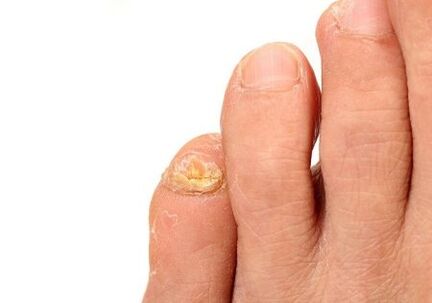
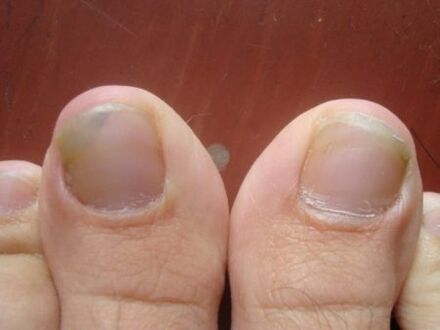
If nail fungus is not treated, the pathogens will transfer to the skin of the feet, causing tinea pedis. In this case, symptoms such as itching, the appearance of cracks in the skin. The patient becomes painful when putting on shoes and walking.
What should I do?
What should you do if you notice signs of a fungal infection? Self-medication is not worth it. A dermatologist should be seen. The specialist will order tests and make an accurate diagnosis. Parents of children need to be especially careful. Of course, in children, nail fungus is not observed too often, however, such a disease occurs at any age.
Remember that the earlier you start treatment, the easier it will be to cope with the disease. If the fungal infection begins to be treated in the early stages, then it can be done using local remedies - ointments, solutions. But you will have to treat patiently, for several weeks.

At the advanced stage, it is necessary to apply not only ointments, but also drugs with a systemic effect, that is, tablets. These drugs are taken orally, from the gastrointestinal tract, the active ingredients are absorbed into the bloodstream, and are carried throughout the body via the bloodstream. Thus, the infection will be destroyed from the inside.
At any stage of the disease, it will be very useful to have a strengthening effect on the immune system. Immunosuppressive drugs, if necessary, will be prescribed by a specialist. And the patient himself needs to set up a rest regimen, sleep more, walk every day. You also need to monitor your diet. The "favorite food" of mushrooms is sugar. Therefore, you need to minimize the amount of sweets in your diet.
So it would be helpful for everyone to know what nail and toe fungus looks like. Such knowledge will help detect early signs of the disease and initiate treatment at the earliest stage. This will allow you to quickly cope with the disease and not use systemic drugs that negatively affect the liver.


























